Web design Hertfordshire: What ranks and why
Search engine optimisation is continually evolving as Google improves its manipulation of search results for its own gain. It is a subject of intense speculation and gossip due to the fact Google’s algorithm is highly guarded and official communication is too vague to have any real meaning. As a result this perpetuates rumour further (and so we go on!). A quick search (on Google!) for any SEO related question will return contrasting views from “so called” experts about the best course of action. In turn it can be very difficult to know what to believe and what to discard.
I decided I would put some of the most widely known rankings factors to the test and to measure how they influenced the results of a particular keyword, in this instance, local SEO keyword ‘web design hertfordshire’. Even as a seasoned SEO professional I was surprised by the results and we have made some improvements to our own internal processes as a direct consequence of this study. Please read on……
Ranking factors
The ranking factors tested were:
- Number of socials shares the ranking page had – measured using http://sharetally.co/
- The ‘Page Authority’ of the ranking page – a metric from Moz.com
- Number of ‘Followed Linking Root Domains’ – again taken from Moz’s Open SiteExplorer
- Page size (mb) – Measured using GTMetrix
- Word count – Measured using Copyscape
- Total mentions of ‘web design Hertfordshire’ on the ranking page – counted manually
- Total mentions of ‘web design’ on the ranking page – counted manually
- Total mentions of ‘Hertfordshire’ on the ranking page – counted manually
All of the above factors are known to influence search engine rankings and thus the purpose of this experiment is to ascertain to what extend each of them do, if at all.
Ranking Websites
The data for this case study was recorded on 07.01.2014. On that day, the top 10 ranking positions for the keyword ‘web design Hertfordshire’ were filled with the following pages (ranking position also listed):
- shystudios.co.uk
- popcornwebdesign.co.uk
- fluidstudiosltd.com
- touchcreative.co.uk
- lemongrassmedia.co.uk
- mvgmedia.com
- awdltd.co.uk
- stablewebdesign.co.uk
- daymedia.co.uk
- herts-webdesign.co.uk
Caveats
As with all experiments, there are certain caveats:
- All data, including ranking positions, were taken on 07.01.14 and therefore the order of the results will have certainly changed by now, as will the data recorded
- It’s worth noting that although the top 10 is filled with homepages, we are measuring data for them as pages, as opposed to as websites
- One keyword and 10 websites is clearly not enough data to prove anything; this post is designed to give insight into how Google works and provoke further discussion/experiments
Results
For each graph, the websites listed are displayed with the 1st ranking position on the left to the 10th ranking position on the right. Each graph has a trend line imposed on it. The steeper this line, the greater the correlation between that metric and the search engine ranking positions.
Number of socials shares the ranking page had – measured using http://sharetally.co/
SEO and social media are frequently discussed together and it’s a common perception that the more active you are on social networks, the higher Google will place you in the organic results. This test aims to prove something slightly different; does Google prefer pages that have been shared on social networks? The graph charts the number of social shares that each ranking page has received:
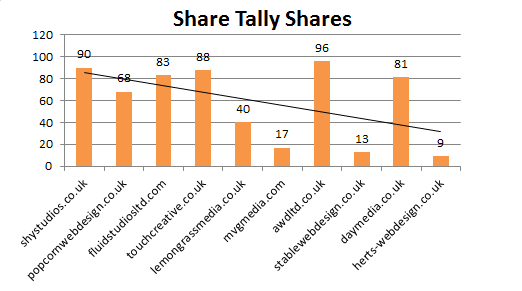
The trend line clearly shows that websites in the top half of the rankings have more social shares than those in the bottom half of the rankings. We can therefore assume that for the keyword ‘web design Hertfordshire’ the number of social shares is an important ranking factor.
The ‘Page Authority’ of the ranking page – a metric from Moz.com
Page Authority is Moz’s attempt at replicating Google’s algorithm and according to its own analysis is the metric that has the closest correlation to Google’s rankings. This graph shows the Page Authority of each ranking page:
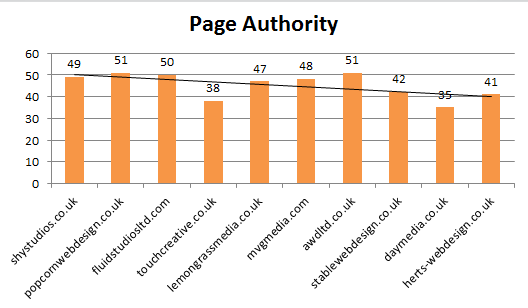
Although the trend line is not as pronounced as the previous graph, it is slanted from top left to bottom right indicating a correlation between the Page Authority of a page and where it ranks. The higher the Page Authority the better.
Number of ‘Followed Linking Root Domains’ – again taken from Moz’s Open Site Explorer
Encouraging links from external sites is a hugely important part of SEO. This measures the total number of domains each webpage has pointing to them i.e. this post links to Moz.com twice, but would only count as one ‘Followed Linking Root Domain’ :
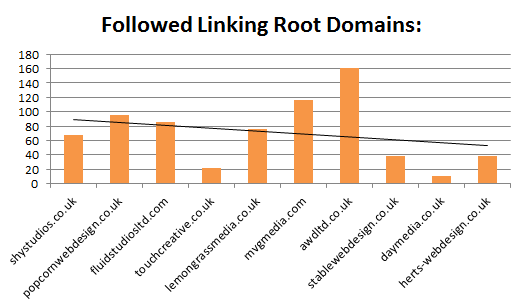
Again we see a trend line with a gradient from left to right indicating that this is a ranking factor. The more websites that link to you the better.
Page size (mb) – Measured using GTMetrix
The smaller the webpage, the quicker it loads, the better the experience of website visitors. In theory you will be rewarded for providing this better experience with higher Google rankings:
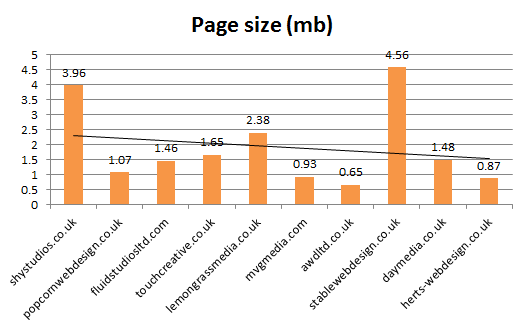
This differs from the previous graphs in that the trend line should go from low on the left to high on the right if it had an effect on rankings (i.e. the smaller the webpage/quicker it loads, the higher up the rankings it is). Our data is actually the inverse of this, with the 1st ranking position being held by the 2nd largest page at almost 4mb (our homepage is almost 10x smaller). Despite being announced as a ranking factor in 2010 it clearly doesn’t have an impact on search results for this query. This isn’t to say it shouldn’t be worked on due to the positive impact it has on your visitors, particularly those with slow internet connections or on mobile devices.
Word count – Measured using Copyscape
It’s generally assumed that longer pages rank better as Google can gain more of an understanding as to the context of the page. Copyscape measures all words on the page i.e. those included in title, body content and menus:
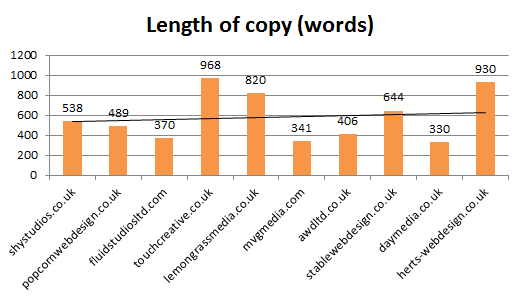
If common theory is to be proved, the trend line would go from high left to low right, but we see the opposite with the websites that rank for this keyword. This implies the words used in the content is more important than simply its length and brings us nicely along to our next measures.
Total mentions of ‘web design Hertfordshire’ on the ranking page – counted manually
‘Keyword density’ used to be an important SEO measure (circa 2000) and whilst I hope no one pays that close attention to it anymore, it seems logical that if you want to rank for a keyword, it’s worth mentioning on the page you are trying to rank at least once!
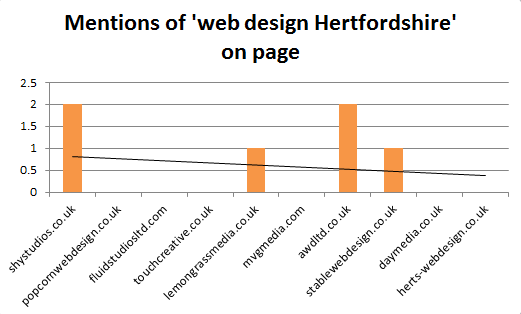
The results from this test really intrigued me. I’m amazed that 6 out of the top 10 results didn’t mention the keyword anywhere on the ranking page. Although the 1st position does mention the keyword twice, this is the same number as the 8th position and therefore it would seem very little importance can be placed on this measure.
Total mentions of ‘web design’ on the ranking page – counted manually
The keyword ‘web design Hertfordshire’ doesn’t exactly roll off the tongue, so I wanted to determine if Google was measuring the context of the page by mentions of just ‘web design’.

As you would expect, this term features far more prominently than the exact keyword but again the graph is the inverse of what most SEOs would expect. I find it astonishing that the term isn’t mentioned at all for 3 out of the top 10.
Total mentions of ‘Hertfordshire’ on the ranking page – counted manually
I was intrigued as to whether Google was at all interested in the number of times ‘Hertfordshire’ was used on the page:
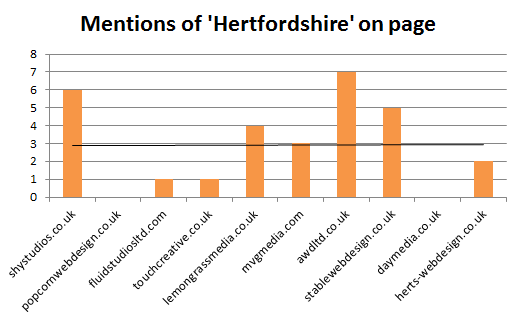
Although the 1st ranking position does mention ‘Hertfordshire’ a significant number of times, 2nd position doesn’t mention it all. The trend line is flat, indicating there is no relevance in this metric on search engine results.
Future experiments
- The study is based on pages of website development sites, all of whom add links to clients’ websites when they launch a new website. I believe this skews the ‘Followed Linking Root Domain’ metric. It would be interesting to re-run this test in a different industry where link profiles aren’t so manipulated
- Further investigation is required into the the quality of incoming links to ranking sites such as their anchor text, or the content theme of linking websites
- Examine the impact of heading tags and title tag on rankings
Conclusions
It would appear that creating web pages that are more likely to be shared on social networks is the key to achieving top ranking positions. I was particularly interested in the use of keywords on optimised pages and the perceived lack of effect this had on rankings. I attribute this to recent efforts at Google to understand better the context and relevance of keywords and therefore webmasters not having to be so explicit with the use of keywords in text. This is a positive development as it should allow website owners to focus on writing copy that is engaging rather than copy that is manufactured around a certain keyword.
Please feel free to comment on any of the above using the form below; I will respond to you individually.



